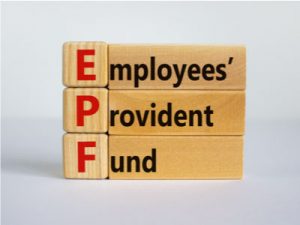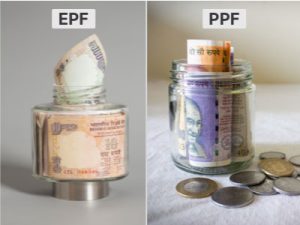EPF vs. PPF – A Comparison
Two popular investment schemes that sound similar but have different features and benefits, EPF and PPF, are a boon for individuals.
EPF or Employee Provident Fund is a retirement plan for salaried individuals that is funded by both the employer and employee while PPF or Public Provident Fund is a savings plan or a retirement fund that is funded individually.
Wondering which one will work for you? Read on to find out.
EPF vs. PPF – At a Glance
Features |
EPF |
PPF |
| Governing Body | Employee Provident Fund Organization | Statutory Scheme of the Central Government of India (offered to public by certain banks and the Post Office) |
| Investor | Employee and employer (only for salaried individuals) | All Indian citizens (minor accounts are handled by their legal guardians) |
| Interest Rate (As on June 2021) | 8.5% | 7.1% |
| Investment Term | Until retirement or permanent resignation | 15 years but can be extended by blocks of 5 years indefinitely |
| Minimum Investment Amount | 12% of basic salary (for the employee) | Rs. 500 per year |
| Tax on Withdrawal | Only if withdrawal is made within 5 years of investment | None |
| Tax Benefits | Yes | Yes |
| Loan | In certain circumstances | Allowed at 1% interest rate |
| Early Withdrawal | In certain circumstances | Partial withdrawal in certain circumstances after 6th year of account opening |
EPF – Employee Provident Fund

If you are a salaried employee, chances are that you have either heard of this scheme or you are a participant in the same. EPF or Employee Provident Fund was started with the goal of creating a retirement corpus for employees while offering tax benefits on the same.
This fund is also unique as it provides not just one but the benefit of three schemes – retirement/savings, insurance, and investment – in just one plan. The employee and the employer contribute 12% of the basic salary each.
This scheme benefits from an interest rate of 8.5% (as on June 2021) and withdrawal is permitted after retirement. However, in case of certain circumstances such as the ongoing COVID-19 pandemic or other emergencies, a withdrawal in the form of a ‘loan’ is allowed. As an EPF contributor, you can also enjoy tax benefits.
Sounds fantastic doesn’t it? If you want to know more about EPF and its numerous benefits in detail, check out our Beginner’s Guide to EPF
PPF – Public Provident Fund

PPF or Public Provident Fund is another savings scheme that can also be used to create a retirement/old-age security corpus but unlike the EPF, the contribution is made by the account holder.
Anybody in India (except NRIs) can open a PPF account either through the Post Office or certain banks including minors whose account will be managed by their legal guardians. This scheme is fantastic for those looking for low-risk investment options or those who cannot invest a lot. You can invest any amount between Rs. 500 – Rs. 1,50,000 per year.
The PPF scheme is generally for a period of 15 years but you can extend it in blocks of 5 years after that. While premature withdrawal is not encouraged, it is permitted in certain circumstances such as medical emergencies, marriage, etc. but only after the 6th year of account opening. Additionally, a loan can also be availed wherein the interest rate imposed is 1%.
This scheme is provided by the Ministry of Finance, Central Government of India and the current interest rate offered is 7.1% (as on June 2021). Another benefit of PPF is that individuals can also avail tax benefits under Sec 80C.
Which one should you invest in?

While both these schemes come with their unique benefits and features, choosing which one to invest in can be based on the following factors –
- Employment
By default, if you are not a salaried employee, you may not be eligible to invest in the EPF scheme. However, PPF is definitely an option to consider due to its many benefits.
- Risk Appetite
If you are new to investing or wary of market fluctuations, then PPF or EPF are the perfect investment options for you. However, while the risks associated with these schemes are low, the returns are also relatively low. Staying invested for a long period of time is key.
- Income
If you are self-employed and your income is uncertain, investing in PPF is a good option as the minimum investment amount is an affordable Rs. 500 per year. However, if you are salaried and have a good income, why not invest in both?
- Investment Goal and Returns
If you are looking for a comfortable post-retirement life, opt for the EPF scheme if possible as the power of compounding will definitely result in a sizable corpus.
While the PPF scheme can be availed by everyone, the interest rates are relatively low and the lock-in period is shorter as well. The returns may therefore not be as high as that offered by EPF.
- Investment Period
Salaried employees can stay invested in the EPF scheme until retirement although premature withdrawal is possible in certain circumstances. However, if a long investment term is not ideal, opt for PPF as the lock-in period is 15 years and partial withdrawal is permitted after the 6th year of investment.
EPF offers more corpus due to the interest rate and the duration of investment but in order to avail the full benefits of it, one must stay invested until he/she retires. The drawback, though, is that this scheme is not available for all.
While PPF has a lower investment period and interest rate, the risk associated with it as well as minimum investment amount required is very low, making it ideal for all. Additionally, both these schemes provide tax benefits.
In short, choosing the right investment option between EPF and PPF is solely dependent on you. Choose what works for your lifestyle and investment goals and invest wisely.
In Conclusion
EPF and PPF are two schemes that have completely changed the investment landscape of the country. Both these schemes are low in risk while providing good returns.
We had mentioned earlier that in cases of emergencies you can avail a loan against these schemes. But what if there was a better option such as a personal loan?
You can now easily avail affordable personal loans from Money View. Not only is the application process quick, but the loan amount is provided within just 24 hours of application approval. Visit the Money View website or download the app to apply today!
Did you enjoy this blog? Let us know what you would like to read about next in the comments below!
Beautiful app